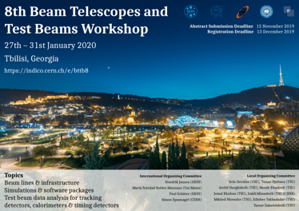Speaker
Description
Future experiments in particle physics foresee few-micrometer single-point position resolution in their vertex detectors, motivated by e.g. b-tagging capabilities. Instead of scaling down pitch sizes the so-called enhanced lateral drift (ELAD) sensor concept seeks to improve the position resolution by increasing the lateral size of the charge distribution already during the drift in the sensor material. To this end, it is necessary to carefully engineer the electric field in the bulk of the ELAD sensor. This is achieved by introducing volumes with additional doping (buried implants) inside the bulk which influence the charge carriers' drift paths.
To find an optimal sensor design, detailed simulation studies were conducted using SYNOPSYS TCAD. The geometry of the buried implants, their doping concentration and the position inside the sensor were optimised for different sensor thicknesses.
To estimate the position resolution of the ELAD sensor, test beam simulations using the AllPix2 software have been performed applying the realistic electric field profiles from the TCAD simulations. In the AllPix2 simulations, 2D and 3D electric fields have been used. Results of the geometry optimisation are shown realising an optimal charge sharing and hence position resolution.
A position resolution of a few micrometers is expected by using buried implants without relying on a Lorentz drift or tilted incident angle. Results on the resolution studies for different sensor thicknesses are presented.




